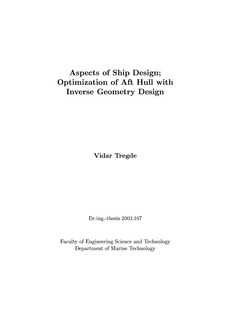| dc.contributor.author | Tregde, Vidar | nb_NO |
| dc.date.accessioned | 2014-12-19T11:24:29Z | |
| dc.date.available | 2014-12-19T11:24:29Z | |
| dc.date.created | 2004-03-12 | nb_NO |
| dc.date.issued | 2003 | nb_NO |
| dc.identifier | 122044 | nb_NO |
| dc.identifier.isbn | 82-471-5663-6 | nb_NO |
| dc.identifier.uri | http://hdl.handle.net/11250/231147 | |
| dc.description.abstract | The main contribution of this thesis is on the study of optimization methods in aft hull design. The optimization methods are inverse geometry design methods to find an aft hull with the flow velocities we specify. The analytic foundation for the flow is given by Stratford in [31], and gives a prescribed velocity distribution on the aft body. With the parameter β we have adjusted this flow to have a certain margin to separation along the pressure recovery region.
This principle and optimization method are successfully applied to design of ships with pram-type aft hull. The 2D optimized profiles corresponds to centerline buttock, and 3D hull sections are extended from this centerline buttock with a bilge radius.
Stratfords original pressure distribution for pressure recovery region were meant for Reynolds numbers up to 107. We have extended Stratfords formula to yield for ship full scale Reynolds numbers to 109.
Different optimization methods were programmed and tested. The best routine for our optimization of aft hull with Stratford flow, was when the offset y-value were the optimization parameter to be changed. When we tried to optimize a complete 2D profile with a given pressure distribution, it worked best to use the variables in a B-spline as the optimization parameter.
Extensive windtunnel tests and towing tank tests are carried out. The tests verified the hydrodynamic properties of the hulls.
Towing tests indicates that the optimized hull lines have lower total resistance than conventional ships with the same main dimensions. Both the frictional, viscous pressure resistance and wave making resistance are significantly lower. Further we can increase cargo capacity with the same power consumption, and achieve a more favourable distribution of the displacement in the aft hull.
This study has shown us that the slant angle for the bottom of the aft hull should not excess 15º with horizontal plane due to danger of separation over the bilge, and longitudinal vortices forming. | nb_NO |
| dc.language | eng | nb_NO |
| dc.publisher | Fakultet for ingeniørvitenskap og teknologi | nb_NO |
| dc.relation.ispartofseries | Dr. ingeniøravhandling, 0809-103X; 2003:107 | nb_NO |
| dc.subject | Ship design | en_GB |
| dc.subject | inverse design methods | en_GB |
| dc.subject | ship resistance | en_GB |
| dc.title | Aspects of ship design: optimization of aft hull with inverse geometry design | nb_NO |
| dc.type | Doctoral thesis | nb_NO |
| dc.source.pagenumber | 142 | nb_NO |
| dc.contributor.department | Norges teknisk-naturvitenskapelige universitet, Fakultet for ingeniørvitenskap og teknologi | nb_NO |
| dc.description.degree | dr.ing. | nb_NO |
| dc.description.degree | dr.ing. | en_GB |
